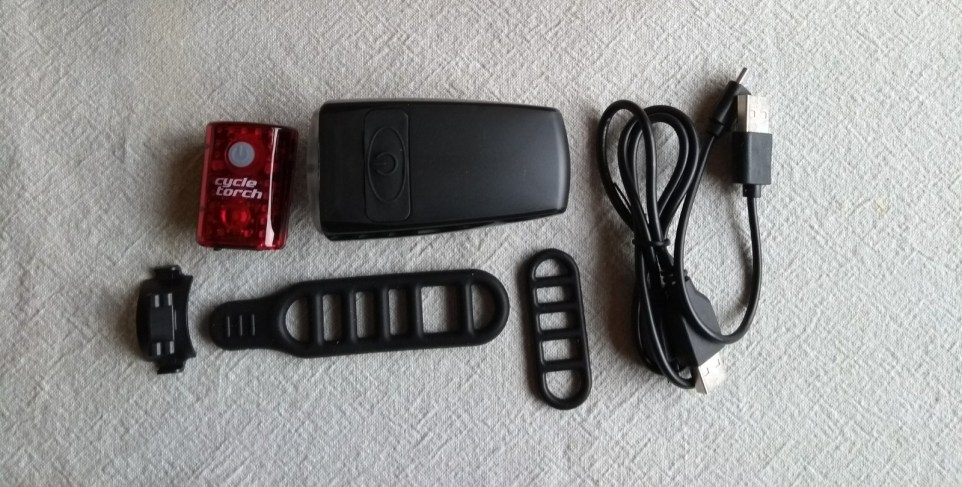
Last week I reviewed the Cycle Torch Night Owl, an affordable, bright light designed for bike commuting. This week I’m taking a look at its big brother: the Shark 500.
I’ve been really impressed with this light and both myself and my husband have been using it on our bikes. In fact, my husband loves it so much that he’s come up with a way of attaching it to the headband he normally uses for his heavier, battery-pack torch so he can use it for night orienteering.
Cycle Torch Shark 500: Vital Stats
Weight:
Lumens: 500
Modes: 4 (3 levels of brightness + flash)
Run-time: 1.5-30 hours
Where to buy: In the UK, it’s available from Amazon.
First Impressions
 The Shark comes in a simple but stylish box. Open it up and you get a thank you note from the company, underneath which is the torch, neatly packaged in foam casing. In fact, you actually get two torches – Cycling Torch throw in a rear light to give you a bit more for your money. Also in the box are three attachment straps of different lengths and two USB charging cables. There’s no instruction manual, but you can download one online.
The Shark comes in a simple but stylish box. Open it up and you get a thank you note from the company, underneath which is the torch, neatly packaged in foam casing. In fact, you actually get two torches – Cycling Torch throw in a rear light to give you a bit more for your money. Also in the box are three attachment straps of different lengths and two USB charging cables. There’s no instruction manual, but you can download one online.
 For a low-cost bike light, the Shark is pretty stylish, if a little on the large size. The front end is unusual for a bike light in that the plastic casing extends over the light itself. More on this later.
For a low-cost bike light, the Shark is pretty stylish, if a little on the large size. The front end is unusual for a bike light in that the plastic casing extends over the light itself. More on this later.
The Shark 500 has an IP65 water resistance rating. This is defined as “dust tight” and protected against water projected from a nozzle. The weak point in terms of water resistance – the USB charging point – has a thin rubber cap to seal it from the elements. Which I somehow managed to pull straight out of the torch body. (Tip: don’t do this, it’s a complete pain to fiddle back in.) It works but is a bit awkward – the thicker plug on the rear light is much easier to secure.
 Both the main torch and the rear light are charged via USB. They charge quickly, the main light back to full power in around four hours. The power button on the Shark glows red when charging and switches to blue when fully charged. The rear light glows green when fully juiced.
Both the main torch and the rear light are charged via USB. They charge quickly, the main light back to full power in around four hours. The power button on the Shark glows red when charging and switches to blue when fully charged. The rear light glows green when fully juiced.
If you read the manual (or this post) you’ll discover that by pressing and holding the power button, you can find out how much charge the torch has left. 10 flashes indicate 100 percent charge, 9 flashes indicate 90 percent charge, and so on.
Setup and Bike Attachment Points
Both the front and rear lights attach using the rubber straps provided. The rear light is super easy to get on and off, the front light slightly less so. Both feel secure once on, even when riding on bumpy paths. I haven’t had them long enough to test the longevity of the bands but they seem pretty rugged.
Testing in the Dark
Right, now we’ve got the preliminaries out of the way, let’s get on to how it does in action. I took the Shark 500 out on a ride on local, averagely-lit roads (I don’t live in the city) and down the local canal to test it in an unlit environment.
 The Shark 500 has four modes: high (500 lumens), medium (250 lumens), low (50 lumens) and flash. Both the high and medium settings are bright enough to light your way on roads in partially lit areas. The 500 lumens setting was also great for off-road riding. It’s not bright enough for fast downhill or really rough mountain biking but it’s definitely a step up on the Night Owl.
The Shark 500 has four modes: high (500 lumens), medium (250 lumens), low (50 lumens) and flash. Both the high and medium settings are bright enough to light your way on roads in partially lit areas. The 500 lumens setting was also great for off-road riding. It’s not bright enough for fast downhill or really rough mountain biking but it’s definitely a step up on the Night Owl.
With most bike lights you get a circular light but the Shark is different. The plastic casing cuts off the beam at the top and bottom creating a rectangular beam of light. The cut off at the top helps focus the beam and prevents you dazzling oncoming cyclists or drivers. Having been dazzled myself plenty of times in the past, I appreciate this! However, the plastic casing on the bottom is not so helpful. It limits the field of light so you can either focus on the ground around your front wheel or further ahead. Logically, you have to go for looking ahead, which on the road is fine, but for off-road biking, I’d have liked to have a wider field of vision.
According to the manual, you get 1.5 hours of light on the top power setting. I actually got a lot longer this – about 2 hours and 40 minutes. The torch flashes and the power button turns red to warn you you’re low on charge twenty minutes before it gives out. On the medium setting, you get three hours of light, and for most bike commuters the 200 lumens will be bright enough.
The rear light isn’t bad, but you’ll probably want a dedicated rear light if you spend a lot of time biking in the dark. The battery life on this was disappointing. It’s supposed to last two hours on the brightest setting, but after an hour and forty minutes the beam faded and pulsed. It stayed on for another hour but not really at a usable level.
Summary
For the price point, the Shark 500 gives you a lot for your money. It’s much brighter than the Night Owl and definitely a better option if you cycle on unlit roads or off-road tracks. For technical mountain biking at night you may need a brighter (and more expensive) light but as far as value for money goes, the Shark 500 gets top marks.
Full disclosure: Cycle Torch provided me with the Night Owl light to test. This review is my honest, unbiased experience of using the bike light.


 The Night Owl is neatly packaged. When you first open the box, a big “Thank You” message is the first thing you see. I was expecting this to be an instruction sheet, but this appears to be the one thing you don’t get with the light. Still, at least it saves some trees. (If you’re the sort of person who enjoys reading manuals, you can find it online
The Night Owl is neatly packaged. When you first open the box, a big “Thank You” message is the first thing you see. I was expecting this to be an instruction sheet, but this appears to be the one thing you don’t get with the light. Still, at least it saves some trees. (If you’re the sort of person who enjoys reading manuals, you can find it online  The light itself is neatly wrapped and tucked into a custom-cut foam casing. This is actually a set of lights: along with the main front light, you also get a “free” tail light, which is nice. Also in the box are two USB charging cables, a plastic mount for the rear light and two rubber straps to attach the lights to your bike.
The light itself is neatly wrapped and tucked into a custom-cut foam casing. This is actually a set of lights: along with the main front light, you also get a “free” tail light, which is nice. Also in the box are two USB charging cables, a plastic mount for the rear light and two rubber straps to attach the lights to your bike. Unlike some lights, the Night Owl doesn’t have a separate mount that needs to be screwed onto your handlebars, which means there’s virtually no setup. You just whack the light on and snap the rubber band around the handlebar to secure it. It’s a bit too fiddly to put on with gloves, but the band has a tab which makes it super easy to take the light off, even if you’re wearing winter gloves.
Unlike some lights, the Night Owl doesn’t have a separate mount that needs to be screwed onto your handlebars, which means there’s virtually no setup. You just whack the light on and snap the rubber band around the handlebar to secure it. It’s a bit too fiddly to put on with gloves, but the band has a tab which makes it super easy to take the light off, even if you’re wearing winter gloves.

